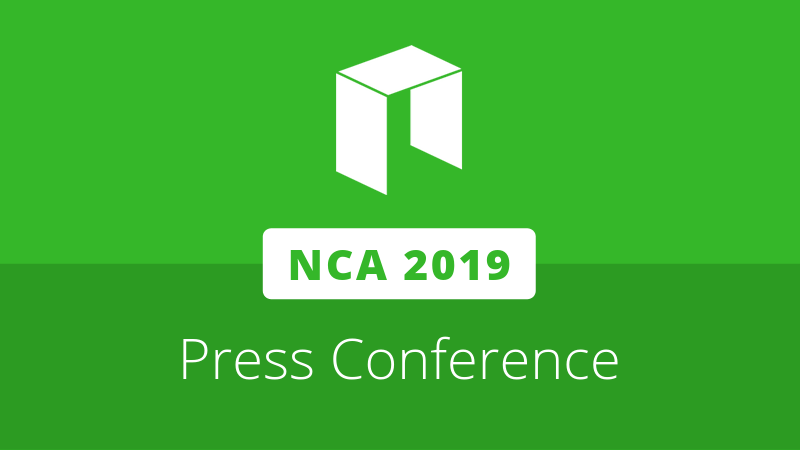
On September 5th, NEO Global Development (NGD) held a press conference at the Hyatt Regency Shanghai as part of the inaugural NEO Community Assembly (NCA). During the event, several ecosystem projects announced the launch of new products, including the NEO Blockchain Toolkit and NEO Express from NGD Seattle, a MainNet ready update for the NEO-ONE development suite, and the NeoFS proof-of-concept for developers from NEO SPCC.
The NCA is an invite-only event where representatives from NEO developer groups are invited to the NGD Shanghai office for a week of intensive discussions and collaborations. Participants of the 2019 NCA include NGD Seattle, NEO SPCC, COZ, NewEconoLabs, NEO NEXT, NEO-ONE, NeoResearch, and Neow3j.
Decoding the Future
Da Hongfei opened the press conference with a presentation titled “Decoding the future,” looking back on NEO’s past and providing an outline of NEO’s future. Da stated that he believes that the blockchain industry has evolved from being focused on coins to chains, and that the next focus will be on “Next Generation Internet” (NGI).
Da broke the infrastructure of the NGI down into four layers—the content neutral network, state & settlement, transaction, and application—and suggested that NEO’s position sits within the state & settlement and transaction layers. Here, NEO can focus on digital asset issuance and provide components such as decentralized ID, distributed storage, oracles, state channels, and side/cross-chains.
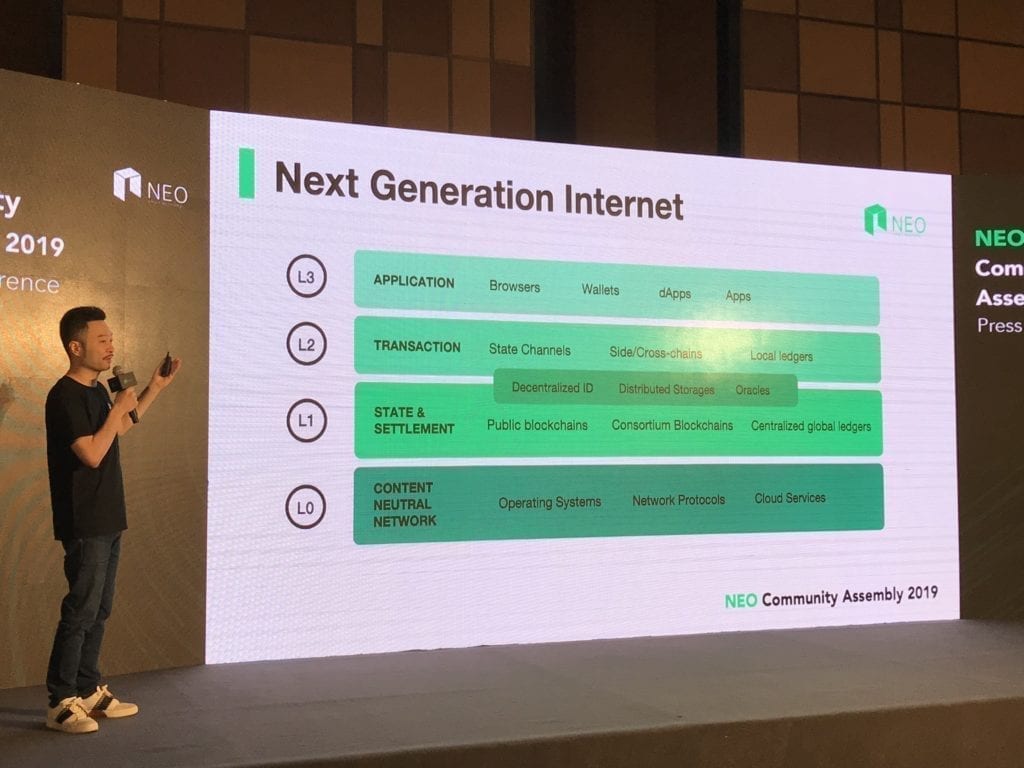
Next, Da outlined ongoing projects for NGD, including NEO EcoBoost and the development of an interoperability protocol. The NEO EcoBoost program is a commitment from NGD to invest US$100 million of resources into the NEO ecosystem with a goal of allowing it to flourish.
The interoperability protocol is a joint project with Ontology to create a cross-chain protocol with a goal of connecting existing public blockchains. The protocol aims to achieve transactional atomicity with a low barrier to entry and an eco-friendly approach that does not include the issuance of a token.
Finally, Da shared some of the outcomes from discussions at NCA 2019, commenting on the shared experiences and ideas on the path to NEO3.
The NEO F5 Experience
Next, head of NGD Seattle, John deVadoss, took the stage to share the release of new tooling built by the branch’s chief architect, former Microsoft engineer Harry Pierson.
deVadoss began by outlining what he describes as the NEO F5 experience, drawing an analogy between climbing a mountain and skiing. Taking a poll from the audience, deVadoss established that more people enjoy skiing than climbing a mountain, with climbing being the gruelling task. NGD’s work, he said, was to climb the mountain for developers so they can ski down, an analogy for how simple they intend to make development for the everyday engineer.
deVadoss showed a slide demonstrating the disparity between the number of developers globally, 21 million, verses the number of blockchain developers, which is estimated to be around 150,000. Of the global developer segment, around 7 million of these are .NET and Visual Studio developers, which is the platform for which the new NGD release is built.
NEO aim to service these developers with the NEO Blockchain Toolkit, which can be used to write, compile, and debug NEO smart contracts from within Visual Studio Code. NGD Seattle are also releasing the NEO Express node, which aims to make it easy to create, launch, and manage a single- or multi-node private NEO network in a simple manner. The release is built on the MainNet codebase, ensuring consistency and symmetry for developers moving between PrivateNet and MainNet environments.
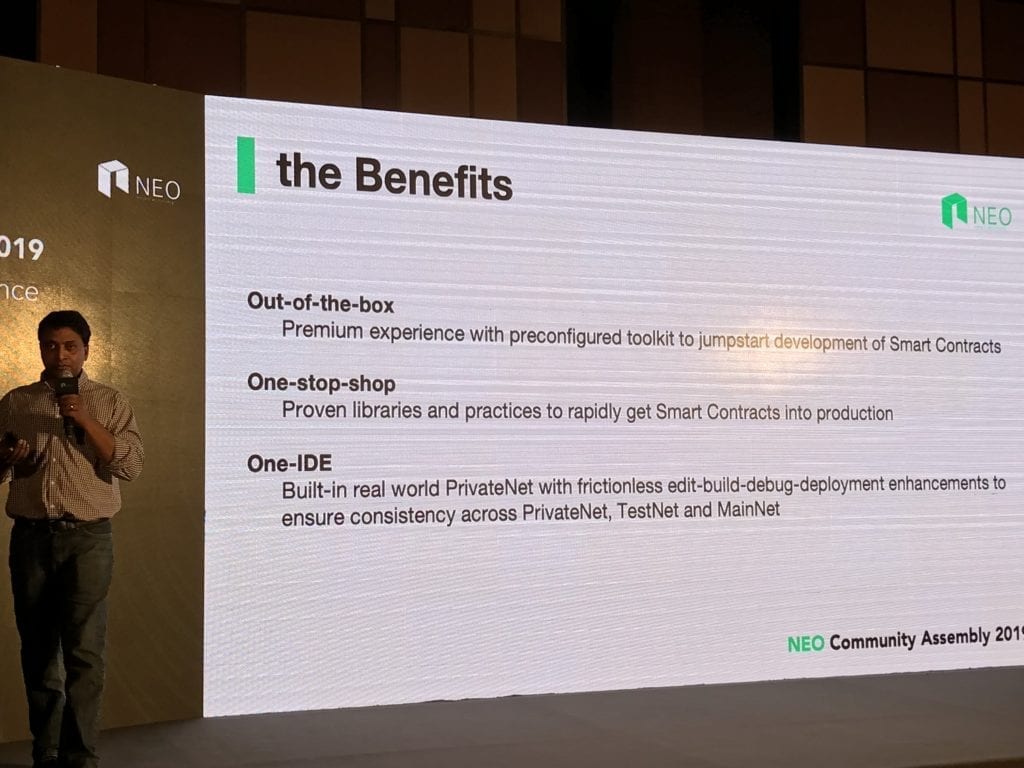
The benefits are slated to be an out-of-the-box premium experience with a preconfigured toolkit to jump-start development of smart contracts, a one-stop-shop of proven libraries to get smart contracts into production quickly, and only requiring one IDE for all editing, building, debugging, and deployment needs.
The early access preview release of the products is expected to ship this week, with new versions pushed twice a month.
NEO-ONE: A Framework for optimized dApp development
Following deVadoss’ presentation, Alex DiCarlo addressed the audience to announce NEO-ONE’s launch on MainNet. Commenting on what he would like the audience to get out of his presentation, DiCarlo mused, “I want the press to say ‘go try NEO-ONE.’”
NEO-ONE aims to be a one-stop TypeScript framework for NEO blockchain development, to enable “easy, enjoyable, and optimized coding, testing, and deployment of NEO dApps to advance the development of next-gen Internet.”
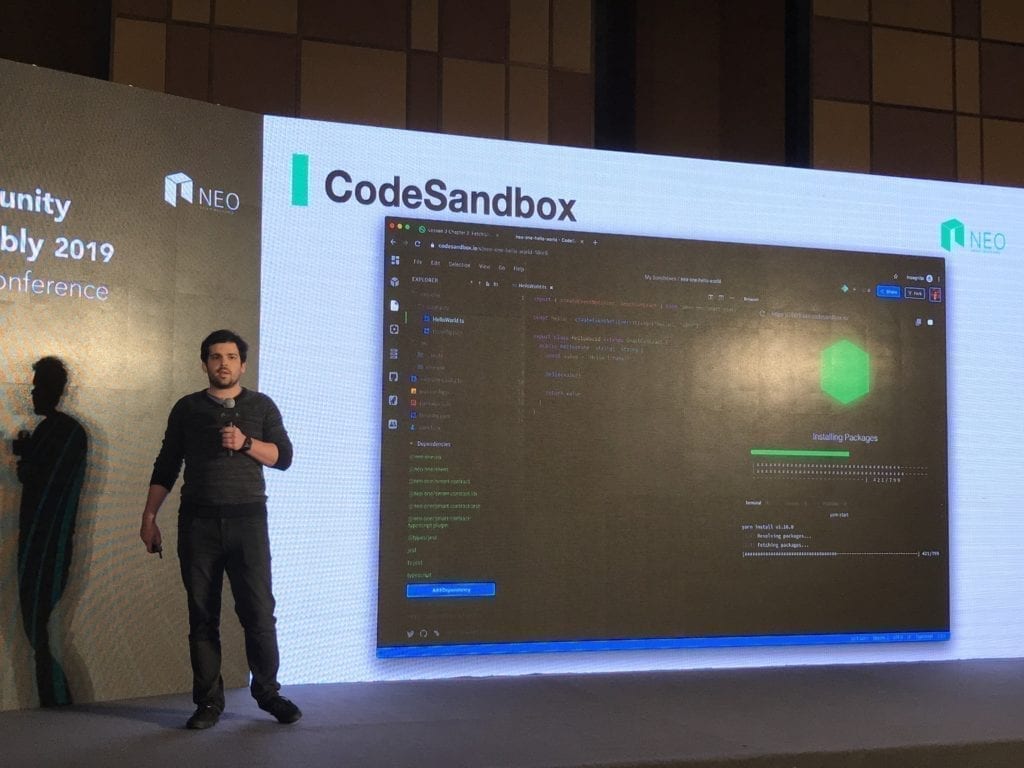
The release of NEO-ONE includes detailed documentation, interactive courses, CodeSandbox integration, and can be launched with one command line that will spin up a complete project for developers to begin working. NEO-ONE can also be run entirely in the browser, with DiCarlo stating that one of the team’s goals was to allow users to get something working on the blockchain in 30 minutes or less.
NEO-ONE 2.0 will ship on Thursday, September 12th.
NeoFS: Public test of distributed decentralized object storage
The final presentation was provided by Stanislav Bogatyrev from Russia-based developer group NEO St Petersburg Competence Centre (NEO SPCC), announcing the launch of the NeoFS proof-of-concept.
NeoFS is a distributed object storage system based on the NEO blockchain. Key features include the ability to directly access stored objects via smart contract code, the use of GAS for payment instead of custom tokens, integration with popular protocols such as HTTP and S3, and almost infinite scalability due to the network map and data placement/retrieval mechanisms.
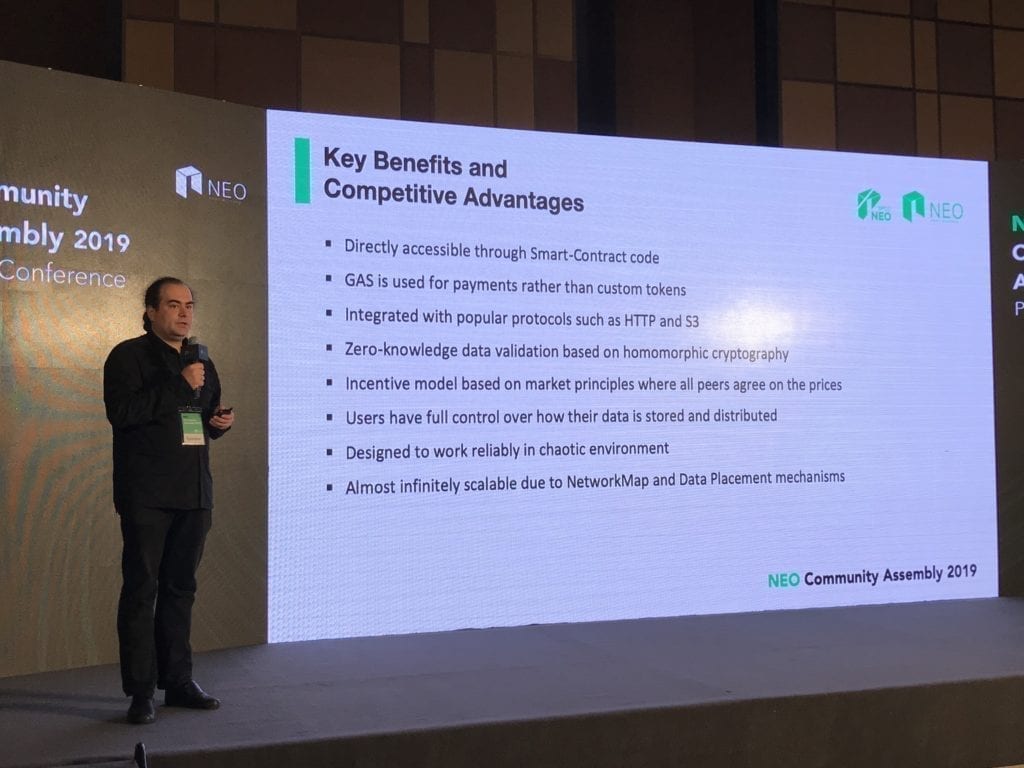
NeoFS also offers zero-knowledge data validation based on homomorphic cryptography, allowing data to be validated in a lightweight manner. The audit system includes multiple test stages, which use game theory to prove that storage nodes are not lying about the data they have stored.
The NeoFS-local environment (SDK) was made available to developers on September 3rd, whilst the closed NeoFS proof-of-concept alpha test with be available on September 23rd. Following a successful test, a public alpha will be made available on September 30th, with an additional public test on the NEO3 TestNet expected in Spring 2020.
Q&A
Following the presentations, all four presenters returned to stage for an open Q&A session.
The Q&A opened with a question for Da regarding centralization within the NEO ecosystem, such as the NEO Foundation, NGD Shanghai, and Da himself, and how they can be seen as potential points of failure.
Da replied that he doesn’t see the world in black and white and that he has yet to find a perfect solution for governance within cryptocurrency and blockchain projects:
“I do believe that decentralization is one of the measures to achieve stability, to mitigate those centralized disadvantages. So actually, with NEO we have a very clear plan to shift from current or centralized model, to a more decentralized in the future. But I also believe it will be of benefit to us to keep relatively centralized to make it more efficient.
NEO is not the first blockchain project in the world. We are catching up with leading projects if we work the same way as bitcoin, or as maybe Ethereum, in a very decentralized manner, I think we will be less efficient compared to today’s development. We have seen some leading projects already stall regarding their technological advancement, so we’d rather choose another road.”
One audience member asked Bogatyrev about the difference between NeoFS and other distributed file storage systems. Bogatyrev replied that the key difference was in the algorithms used for placing data:
“The main idea behind NeoFS is we have the network map that represents the state of the network, the storage policy, which defines how the user data is stored, and applying those filters to the current data in the system. We always can find where we’d like to put an object, and the same function will answer where this object can be found.”
DiCarlo was asked about his experience at the NEO Community Assembly 2019 compared to other historical NEO events, and what he thinks the participants are going to take away from it. DiCarlo noted that the NCA was probably the most unique NEO event he that has been held thus far:
“The Community Assembly is really about bringing together the developers that are pushing the NEO platform forward… The assembly is about the people behind that platform. How are we going to work better together? How are we going to gain empathy by seeing each other in person? And I think the Community Assembly has been a really important factor in getting to know each other.”
Speaking on the topic of how to drive adoption of blockchain tools and applications, deVadoss noted oracles as an illustration of how we can build bridge between the blockchain world and the outside world.
“I strongly believe that this notion of the hybrid application is going to be how we drive adoption. To be able to build a bridge between existing assets and digital assets. Yes, there will be many, many people who play entirely in the digital world, but there will also be many, many people who will perhaps want to have one foot in the old and one foot in the new. And it is my strong belief and conviction that building the bridge – the so-called ‘hybrid dApps’ could be a very powerful way to attract, to draw people, to drive both dApp development as well as adoption of the new platform.”
Blockchain in China Symposium
Later in the afternoon, a closed round table symposium was held to discuss various subjects regarding blockchain in China. Participants included leaders from various Chinese and Asian projects, such as: Zongcheng Li, CFO of Bytom; Kevin Feng, COO of VeChain; Jun Li, founder of Ontology; Hongfei Da, CEO of NGD; John Wang, head of ecosystem growth at NEO; Kyn Chaturvedi, CBDO of TomoChain; Yuanjie Zhang, COO of Conflux; and, Tom Tang, CIO of PlatON.

The event was split into three sessions, each with a different topic. The first session was a discussion regarding building towards the future of blockchain in China, where stablecoins and decentralized exchanges were heavily discussed. Jun Li noted that if the focus of the industry is on exchanges, the industry is not yet mature, noting that the NASDAQ plays an important role in the economy, but it is not the economy. Chaturvedi added that exchanges are looking to become banks, and highlighted how they are increasingly incentivizing people to park their currency on their platforms in return for token rewards and dividends.
The second session focused on how to drive mass adoption in China. Feng stated that VeChain’s approach is to try and overlay it’s technology over existing technologies and that ensuring that its solution is customisable. Feng further noted that companies don’t care what the blockchain they are using, they just want a solution that works, citing his work with Walmart China as an example.
Wang said that he believe that it is important at this point to support small to medium size projects and helping them to grow their userbase. Massive commercialization, Wang believes, is not something that a single chain can do, and that it’s difficult to persuade existing companies to adapt to new environments.
The third and final session tackled the issue of regulation. On the topic of how to reconcile China’s heavy regulation with the open nature of blockchain, Da noted that NEO and Ontology are trying to build platforms, which can be compared to an operating systems, rather than applications, which are more likely to be subject to regulations.
Da also noted that he doesn’t believe “strict” is the right word for describing the state of regulations in China, but prefers the term “clarified.” This, in Da’s opinion can be a positive thing as companies know exactly what they can and can’t do. This is in contrast to the United States, where companies are spending a lot of time and money working to try and determine what is legal and what is not in the eyes of the law.





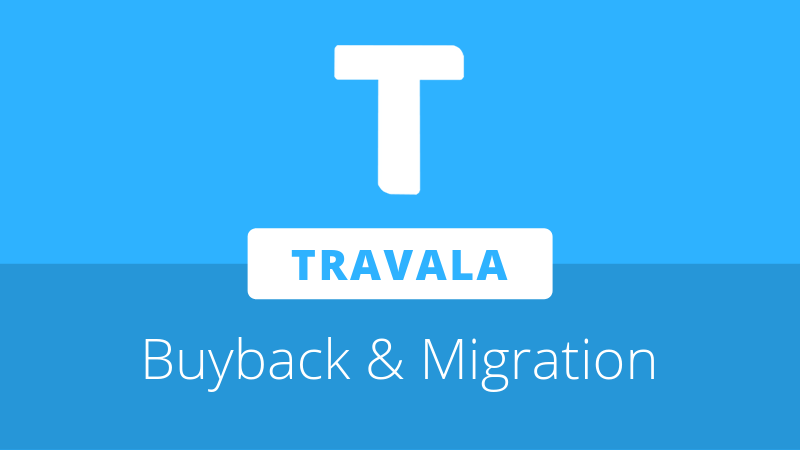
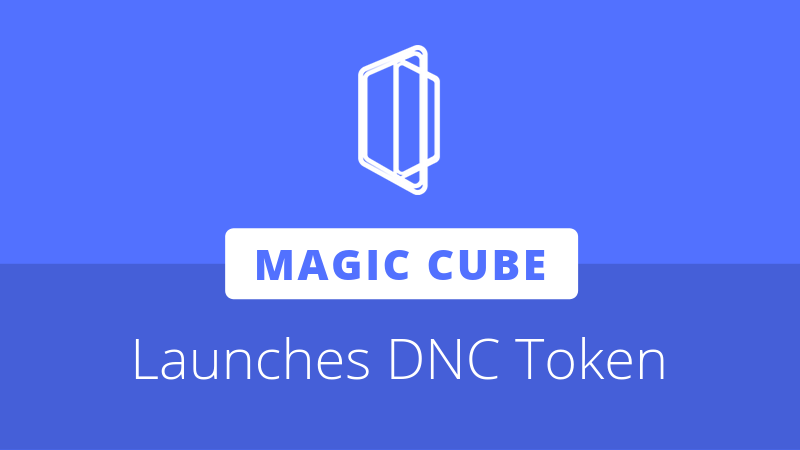
About The Author: Dean Jeffs
Dean is a digital project manager who has worked extensively with start ups and agencies in the marketing space. Fascinated by the potential applications of blockchain technology, Dean has a passion for realising the new smart economy.
More posts by Dean Jeffs